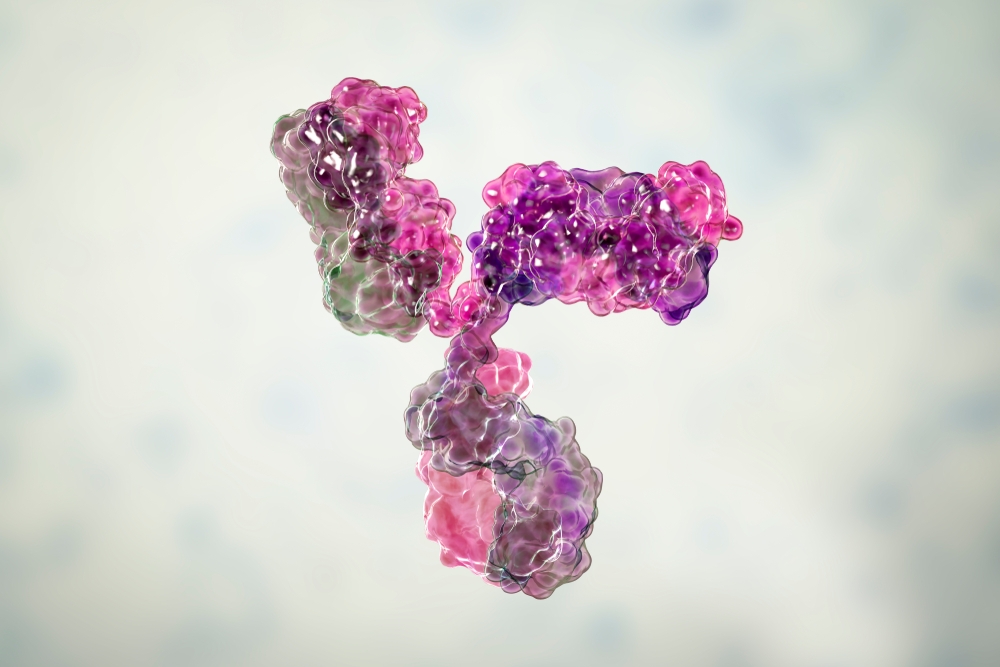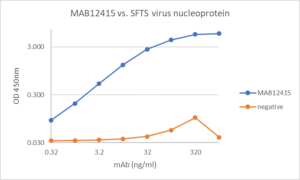ELISA: Antibody titration against SFTS virus nucleoprotein. Antigen coated onto microtitre plate (1µg/ml) overnight in DPBS 2-8ºC. Plate washed 2 X 300µl DPBS+1% BSA (Sigma A7906) with second wash left in plate 2 hours at room temperature. Plate washed 1 X 300ul PBS + 0.1% Tween 20. Dilutions of antibody added at 100µl/well in DPBS + 1% BSA + 0.1% Tween 20, incubated shaken 3 hours at 23ºC. Plate washed 3 X 300µl PBS + 0.1% Tween 20 Anti-mouse Ig-HRP (Southern Biotech 1010-05) diluted 1:10,000 in DPBS + 1% BSA + 0.1% Tween 20. Added 100µl/well, incubated shaken 1 hour at 23ºC. Plate washed 6 X 300µl PBS + 0.1% Tween 20 TMB (Europa MO701A) added at 100µl, incubated static 15 min 23ºC. Reaction stopped 100µl 1M HCL (200µl for wells >4.0 OD units). Plate read at 450nm and 405nm. OD values in excess of 4.0 units estimated from the OD405nm reading.
Mouse Anti-SFTSV Nucleoprotein Antibody (DC12)
Price range: $456.15 through $1,141.42 excl. VAT
SFTSV Nucleoprotein antibody (DC12) is an unconjugated mouse monoclonal antibody against Severe Fever with Thrombocytopenia Syndrome Virus (SFTSV) Nucleoprotein.
MOUSE ANTI-SFTSV NUCLEOPROTEIN ANTIBODY (DC12)
SFTSV Nucleoprotein antibody (DC12) is an unconjugated mouse monoclonal antibody against Severe Fever with Thrombocytopenia Syndrome Virus (SFTSV) Nucleoprotein.
PRODUCT DETAILS – MOUSE ANTI-SFTSV NUCLEOPROTEIN ANTIBODY (DC12)
- Mouse Anti SFTSV Nucleoprotein Antibody (DC12), clone number: DC12.2.G10.A10.D5.
- Isotype – Mouse IgG1 Kappa.
- Immunogen used SFTSV Nucleoprotein, amino acids 2-245 (REC31654).
- Protein G purified, presented in PBS, pH 7.4.
BACKGROUND
Severe fever and thrombocytopenia syndrome virus (SFTSV) is a segmented, negative-strand RNA Phlebovirus belonging to the Bunyaviridae family. SFTSV is a tick-borne bunyavirus, which was first recognised in China in 2009 (Yu, XJ). Since 2009, reported cases of SFTSV infection have increased dramatically, occurring predominantly in China, South Korea and Japan, but also in the US and Mediterranean countries. Tick-borne phleboviruses (TBPVs) can classified into four distinct groups; Uukuniemi group, Bhanja group, Kaisodi group and SFTS/Heartland virus group (Matsuno et al., 2015)
The SFTSV genome contains tri-segmented negative-sense single-stranded RNAs (-ssRNAs), including large (L), medium (M), and small (S) segments (Yu et al., 2011). The L segment encodes the RNA-dependent RNA polymerase (RdRp), the M segment encodes a precursor of glycoproteins (Gn and Gc), and the S segment encodes both a nucleocapsid protein (NP) and a nonstructural protein (Jiao et al., 2011). The Gn and Gc glycoproteins form a heterodimer and shape the spikes on the surface of the virion, for receptor binding and virus entry. The C-type lectin, DC-SIGN, has been identified as one of the factors for SFTSV attachment and entry into cells (Hofmann et al., 2013). The nucleocapsid protein (NP) is essential for viral replication; it facilitates viral RNA encapsidation and is responsible for the formation of the ribonucleoprotein complex (Zhou et al., 2013). The N protein is highly immunogenic and conserved among all isolates in each of the phleboviruses. Therefore, N protein is often selected as a target of antigen and antibody detection (Fukuma et al., 2016).
Currently, there is no treatment for SFTSV infection and it is recognised by the World Health Organization as an emerging highly pathogenic virus, which presents a significant threat to human health (WHO). The viral RNA level in sera of patients with SFTS is strongly associated with clinical outcomes and diagnostic tools with high sensitivity and specificity are needed in disease endemic areas.
REFERENCES
- Fukuma A, Fukushi S, Yoshikawa T, et al. (2016). Severe Fever with Thrombocytopenia Syndrome Virus Antigen Detection Using Monoclonal Antibodies to the Nucleocapsid Protein. PLoS Negl Trop Dis. 2016;10(4):e0004595.
- Hofmann H, Li X, Zhang X, et al. (2013). Severe fever with thrombocytopenia virus glycoproteins are targeted by neutralizing antibodies and can use DC-SIGN as a receptor for pH-dependent entry into human and animal cell lines. J Virol. 2013;87(8):4384‐4394.
- Jiao et al. (2011). Preparation and evaluation of recombinant severe fever with thrombocytopenia syndrome virus nucleocapsid protein for detection of total antibodies in human and animal sera by double-antigen sandwich enzyme-linked immunosorbent assay. J Clin Microbiol 50, 372–377.
- Matsuno K, Weisend C, Kajihara M, et al. (2015). Comprehensive molecular detection of tick-borne phleboviruses leads to the retrospective identification of taxonomically unassigned bunyaviruses and the discovery of a novel member of the genus phlebovirus. J Virol. 2015;89(1):594‐604.
- Yu, XJ et al. (2011). Fever with thrombocytopenia associated with a novel bunyavirus in China. N Engl J Med. Apr 21;364(16):1523-32
- World Health Organization: Risk assessment of human infection with a novel bunyavirus in China.
- Zhou H, Sun Y, Wang Y, et al. (2013). The nucleoprotein of severe fever with thrombocytopenia syndrome virus processes a stable hexameric ring to facilitate RNA encapsidation. Protein Cell. 2013;4(6):445‐455.




